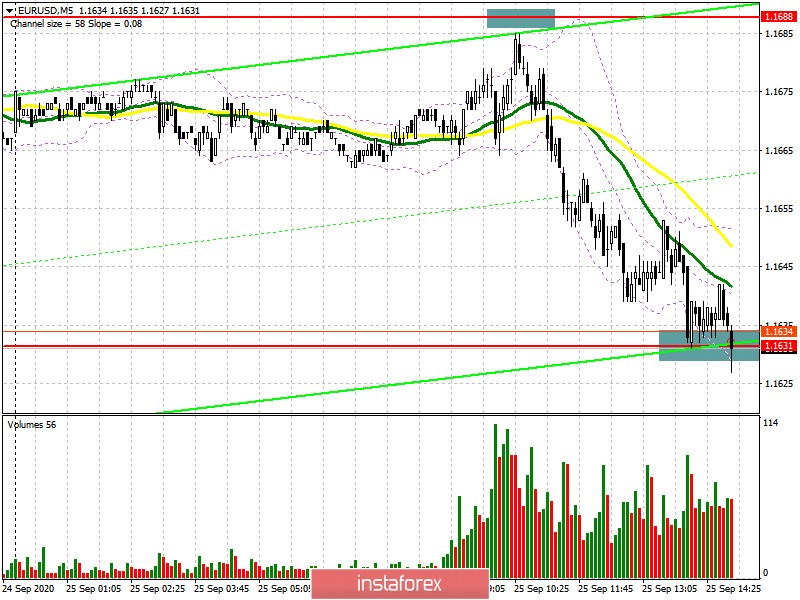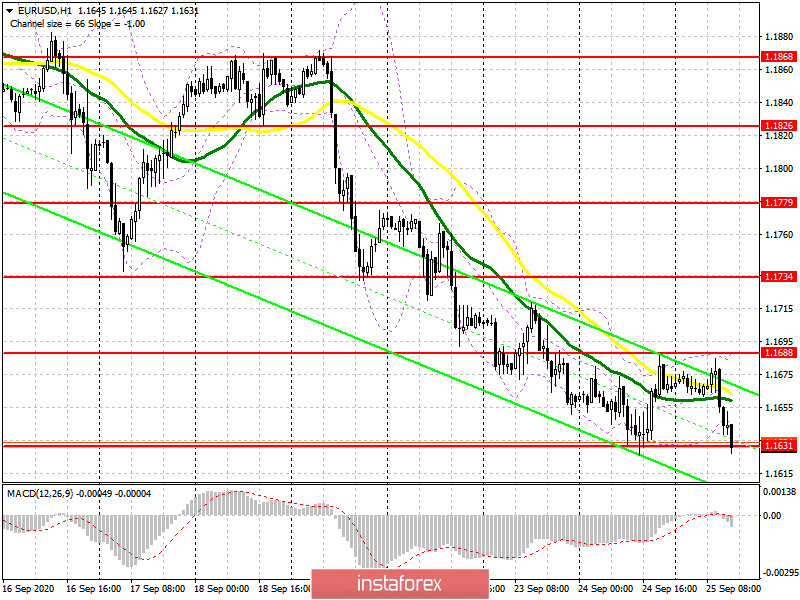Unfortunately, I did not wait for the formation of a false breakout at the level of 1.1688 in the morning, to which we fell a couple of points short. As a result, the entire downward movement of the euro passed. At the moment, the focus is on the support of 1.1631, and the further direction of the pair will depend on how the pair behaves at this level. The formation of a false breakout forms a signal to buy the euro to return to the area of today's maximum of 1.1688, where I recommend fixing the profits. In the scenario of a further decline in the EUR/USD trend under this level, it is best to wait for the update of the new local support of 1.1585 and open long positions on the pair, counting on correction of 20-30 points within the day. There may be a fairly large surge in the volume area of 1.1585 that will also indicate the exit of major sellers of the euro from the market after the trend movement observed since the beginning of September this year.

To open short positions on EURUSD, you need to:
Sellers of the euro formed a downward movement of the pair a little earlier than predicted and their main task in the afternoon will be to break through and consolidate below the local minimum of 1.1631. A test of this level from the bottom up after the breakout forms a good entry point for short positions in the expectation that the euro will continue to decline along with the trend to the area of the minimum of 1.1585. Fairly large profit-taking on short positions may occur here. If there is no movement of the pair up from this area, you can expect to update the minimum of 1.1541. In the scenario of forming a false breakout at 1.1631 in the afternoon, I recommend not to rush with sales, but to wait for the repeated test of the maximum of 1.1688 and sell the euro from there immediately on the rebound in the expectation of correction of 20-30 points within the day.

Signals of indicators:
Moving averages
Trading is conducted below 30 and 50 daily moving averages, which indicates continued pressure on the euro and the formation of a bear market.
Note: The period and prices of moving averages are considered by the author on the hourly chart H1 and differ from the general definition of classic daily moving averages on the daily chart D1.
Bollinger Bands
A break of the lower limit of the indicator in the area of 1.1631 will lead to a larger decline in the euro. Growth will be limited by the upper level of the indicator in the area of 1.1688.
Description of indicators
- Moving average (moving average determines the current trend by smoothing out volatility and noise). Period 50. The graph is marked in yellow.
- Moving average (moving average determines the current trend by smoothing out volatility and noise). Period 30. The graph is marked in green.
- MACD indicator (Moving Average Convergence / Divergence - moving average convergence / divergence) Fast EMA period 12. Slow EMA period 26. SMA period 9
- Bollinger Bands (Bollinger Bands). Period 20
- Non-profit speculative traders, such as individual traders, hedge funds, and large institutions that use the futures market for speculative purposes and meet certain requirements.
- Long non-commercial positions represent the total long open position of non-commercial traders.
- Short non-commercial positions represent the total short open position of non-commercial traders.
- Total non-commercial net position is the difference between short and long positions of non-commercial traders.
 Español
Español 
 Русский
Русский English
English Bahasa Indonesia
Bahasa Indonesia Bahasa Malay
Bahasa Malay ไทย
ไทย Deutsch
Deutsch Български
Български Français
Français Tiếng Việt
Tiếng Việt 中文
中文 বাংলা
বাংলা हिन्दी
हिन्दी Čeština
Čeština Українська
Українська Română
Română

